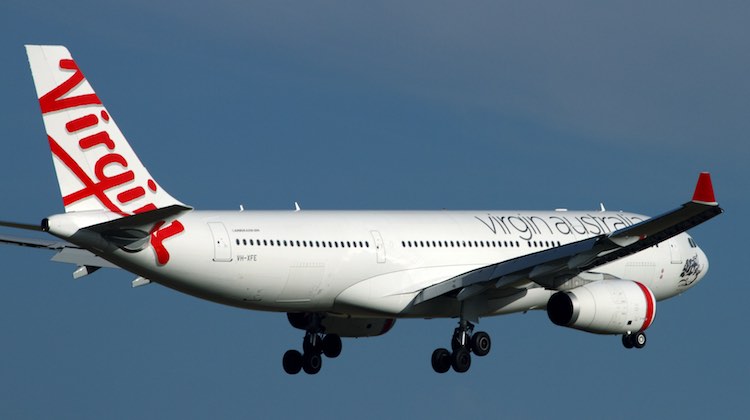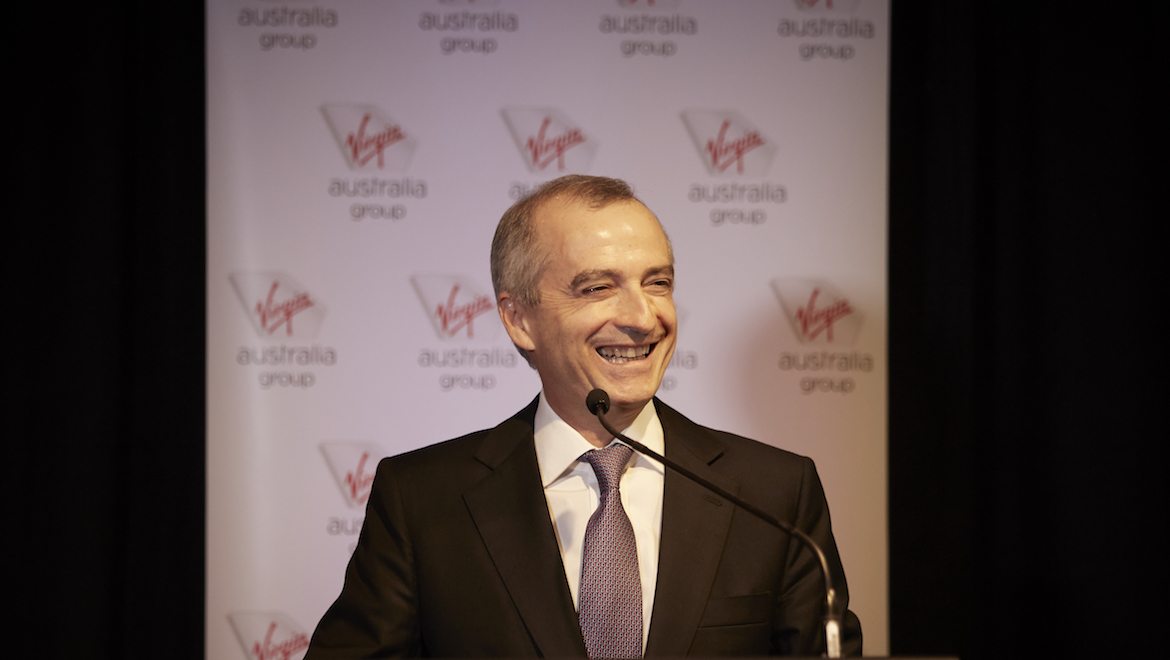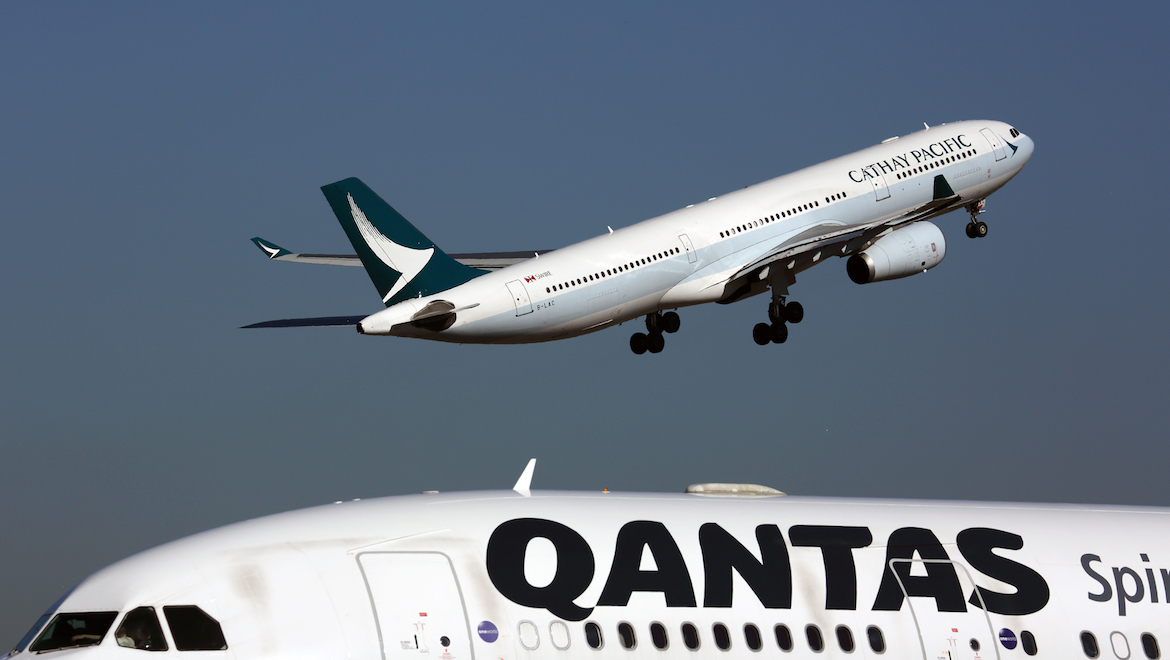
Virgin Australia chief executive John Borghetti has questioned plans from Cathay Pacific and Qantas to expand a codeshare agreement to include flights from the key markets of Brisbane, Melbourne and Sydney to Hong Kong.
Qantas has sought regulatory approval to add it QF airline code on 35 Cathay Pacific-operated flights a week from Brisbane, Melbourne and Sydney to Hong Kong. Meanwhile Cathay Pacific would add its CX airline code on 35 Qantas-operated services a week on those three trunk routes.
The codeshare flights on these routes would only be sold as part of a through journey involving connections either beyond Hong Kong on Cathay Pacific or to other Australian domestic destinations from Brisbane, Melbourne and Sydney on Qantas.
Australia’s International Air Services Commission (IASC), the government body that allocates international airline capacity, is evaluating the application.
Together, Cathay Pacific and Qantas dominate the Australia-Hong Kong market with a combined 90 per cent of total capacity. Virgin Australia is the only other operator with nonstop flights between Australia and the Special Administrative Region (SAR).
Borghetti noted Virgin Australia was only a small player in the Australia-Hong Kong market.
“Let’s be blunt. The amount of capacity that we’ve got on that route versus the two of them is almost insignificant,” Borghetti told reporters during Virgin Australia’s 2018/19 first half results presentation on Wednesday.
“Isn’t it ironic that you had two people that allegedly were competing and charging very high fares on a route and all of a sudden someone comes along with a better product and cheaper fares and the two of a sudden say ‘oh we better get together here because otherwise we can’t make the money that we used to make’.
“Well, I mean that’s competition. Welcome.”

Under an agreement that was struck in the second half of calendar 2018, Cathay Pacific sells codeshare services on flights operated by Qantas in the Australian domestic market, while Qantas sells itineraries that include a Cathay Pacific-operated flight beyond Hong Kong to number of countries in Asia, as well as Cathay’s Perth-Hong Kong and Cairns-Hong Kong. There is no codesharing on routes where both operate their own aircraft.
Qantas’ application to expand the codesharing to include each other’s flights from Brisbane, Melbourne and Sydney to Hong Kong said the move would “not substantially lessen competition on any relevant market”. Rather, it was a “pro-competitive expansion of each carrier’s ability to sell and market itineraries”.
Virgin Australia told the IASC in early February, prior to Qantas unveiling its plans for the expanded codeshare with Cathay Pacific, that it had significant concerns.
The airline has 14 flights a week to Hong Kong – a daily service from Melbourne and Sydney with Airbus A330-200s offering 20 lie-flat business class seats and 255 economy seats at eight abreast.
This compares to Cathay Pacific’s peak schedule of about 72 flights a week between Hong Kong and Adelaide, Brisbane, Cairns, Melbourne, Perth and Sydney with a combination of Airbus A330-300s, A350-900s and Boeing 777-300ERs.
Qantas has 28 flights a week to Hong Kong from Brisbane (daily), Melbourne (daily) and Sydney (double daily) with Boeing 747s, 787-9s, Airbus A330s and A380s.

Borghetti said the proposed Cathay Pacific/Qantas codesharing had parallels with the trans-Pacific market prior to the arrival of new entrants that challenged the incumbents.
“It’s no different to what happened on the Pacific,” Borghetti said. “Arguably, it’s more important than what happened on the Pacific because you’ve only got two players here.”
“It is up to the regulators to make a call. I have a view, as you’d expect, but let’s put things in perspective. We are a very small percentage of the total capacity on that route.”
Prior to Virgin Australia and Delta Air Lines’ entry in the trans-Pacific market, the route was dominated by Qantas and United and generated significant profits for both carriers.
Meanwhile, average load factors – an industry term to describe how full flights are – were above 80 per cent for both Cathay Pacific and Qantas on the Australia-Hong Kong route in the 12 months to October 2018.
Virgin Australia told the IASC the average load factor – an industry measure of how full flights are – on its Hong Kong services was 66 per cent for the 12 months to October 2018
Although the figure was a fair bit lower than the above 80 per cent load factor on both Qantas and Cathay Pacific over the same period, Borghetti said Virgin Australia’s two routes to Hong Kong were performing well, particularly in business class where demand was strong.
“Our premium cabin is just operating beyond any expectation,” Borghetti said.
“Its seat factors are significantly high and from a corporate point of view, ex-Australia specifically, it’s performing extremely well.
“Typically what happens when you start a new route, the hardest cabin to fill is always the premium cabin. Filling the premium cabin on the Hong Kong flight is not a problem for us.”
The two Hong Kong services are operated as part of an alliance with Hong Kong Airlines, which enables Virgin Australia to tap into the growing number of people from China coming to Australia for holidays and business.
This also had a positive impact on Virgin Australia’s domestic network, given those travelling from China to Australia often visited more than one city while in this country.
“I’ve very optimistic about Hong Kong, we’ve seen the good signs,” Borghetti said.

International network remained in the red in 2018/19 first half
The launch of nonstop Sydney-Hong Kong flights in July 2018, as well the expansion of Virgin Australia’s trans-Tasman network following the end of its alliance with Air New Zealand, led to a widening first half loss for the airline’s international operations.
Virgin Australia international posted an underlying earnings before interest and tax (EBIT) loss of $12 million for the six months to December 31 2018, compared with a loss of $2.7 million in the prior corresponding period.
On a more positive note, international revenue rose 15.2 per cent to $666.1 million, while revenue per available seat kilometre (RASK) – an indicator of demand – rose 0.8 per cent.
The new routes led to a 14 per cent growth in capacity, measured by available seat kilometres (ASK), and 8.2 per cent improvement in passengers carried.
Virgin Australia chief financial officer Geoff Smith said higher fuel costs, foreign exchange movements and start -start up costs associated with the new routes was behind the EBIT loss.
“We continue to invest in our greater China strategy and we have a long-term view on the new routes that were launched,” Smith said.
“This remains the fastest-growing and most valuable international market for the group.”
Other investments during the half included the installation of inflight internet Wi-Fi across Virgin Australia’s five 777-300ERs and the roll out of a new international lounge network that includes facilities in Auckland, Melbourne and Sydney, as well as soon-to-open lounges in Brisbane and Wellington.
















Rod Pickin
says:I think it interesting that CX has even entered into talks with QF. For years they have been very aloof, very much the Swire Group, a tad brash, unbending. Recent reports appear to indicate a few speed bumps on the CX commercial highway so maybe this new alliance would be to their benefit. It does appear however that there is a similar situation with the QF/NZ alliance, to me both seem a tad predatory and I think that VA is between a rock and a hard space.
Paul Brunton
says:You don’t mention about Virgin’s bigger concern with Qantas trying to wrest control of Alliance aviation.
Virgin is very much reliant on Alliance providing some of their regional flights.
The Qantas attempt to take over Alliance is about as predatory as it gets.